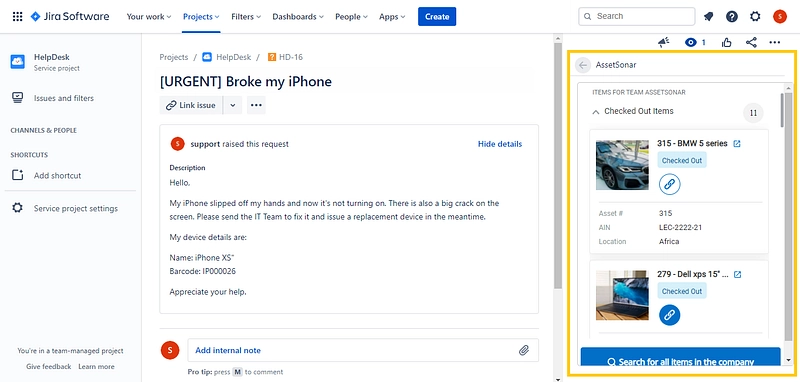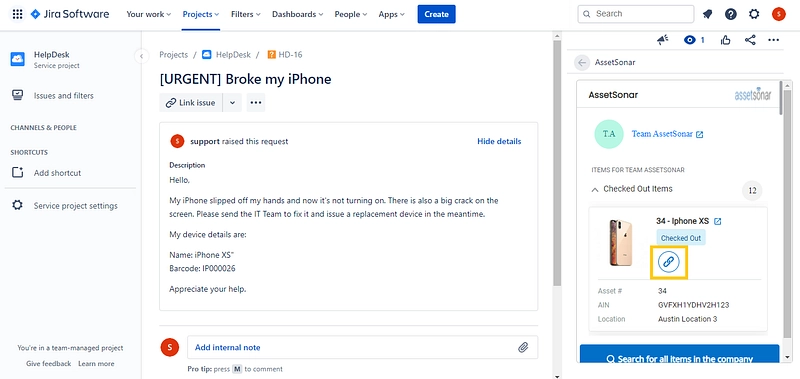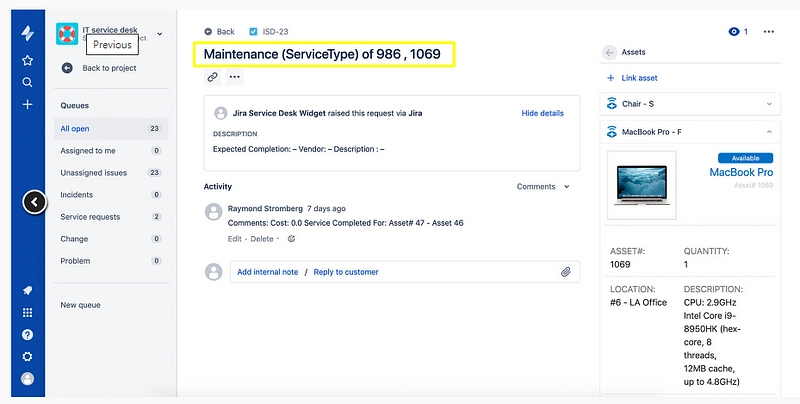What’s new?
The AssetSonar team is excited to announce the launch of its new, fully redesigned interface for the Jira integration. Based on valuable customer feedback, we’ve redesigned AssetSonar’s Jira integration to make the issue resolution experience more accessible, faster, and easier as well as more visually pleasing. Learn more.
Integrate the AssetSonar Plus app with your Jira Service Desk to add comprehensive IT asset management capabilities to your support and ticketing processes. Lower equipment downtime by speeding up issue resolution.
1. Prerequisites
This integration requires:
- A subscription to the Jira Service Desk
- A subscription to AssetSonar
- AssetSonar Plus App from Atlassian Marketplace
2. Need for the integration
Companies using an IT service desk have to track dozens of tickets at a time to fend off delays in company tasks. Most IT service desks aren’t equipped to handle asset details in a comprehensive manner. Thus, cross-referencing items with issues becomes a burden that keeps on stacking.
Imagine being able to extract all relevant IT asset details needed to resolve an issue — without having to switch between browser tabs!
By integrating AssetSonar with the Jira Cloud, you can ensure quick resolution of all IT asset-related issues.
With quick issue resolution, you lower IT equipment downtime. This ensures that your company’s productivity never falters.
3. Complete issue overview
Integrating AssetSonar with Jira enables teams to quickly identify tasks at hand. These include issues associated with each item and useful details such as item location and AINs.
With this integration, you can:
- View the Assets and reporter linked with an issue in Jira. This helps employees quickly view relevant Asset details to understand the problem areas in depth. They can also associate more items if the issue requires.
- Track all Jira issues related to an item directly from the Item Details page in your AssetSonar Account. A Jira Issues tab on the page references all the issues for the item so AssetSonar users can view all relevant issues.
With a complete overview of issues, users can record equipment details and check out replacement items. Extract better insights into an item’s useful life by referring to the issues it has contended with in the past.
Use our integration to iron out operational workflows. You can also cut down on repair time for a more productive office environment.
4. Common workflows
- An employee notices a broken printer and reports an issue. AssetSonar tracks Asset details for the printer and Jira tracks the issue workflow.
- An on-field technician requires help with operating a router. The current user quickly views the issue on Jira and pulls the Asset details for the User.
- A customer requests a RAM upgrade for their laptop. The IT Helpdesk looks up the issue on Jira, pulls up the Asset details for the laptop from AssetSonar, and identifies the upgrade required. All prior issues reported for the laptop are also visible.
- An engineer wants to understand the maintenance requirements for your server unit. He quickly pulls all the relevant issues for the unit from your AssetSonar Account.
- An IT manager wants to update a software application on all company laptops. She creates the issue on Jira and links all company machines to it. Employees in charge will pull up Asset details for all laptops from the service desk and carry out the updates.
5. Installation process
Follow these steps to install and integrate Jira with AssetSonar.
Note: For the integration to work, ensure that the Account Owner in AssetSonar is present as an Admin in Jira. Ensure this is the case before you try integrating the two applications.
5.1. Install AssetSonar For the Jira Service Desk
First, set up the AssetSonar Plus App from your Jira Account.
1. Install AssetSonar for the Jira Service Desk from the Atlassian Marketplace.
2. From your Jira Account, head to Settings → Apps → Manage Apps. You’ll find AssetSonar under User-installed Apps.
3. Hit the configure button and fill in the data fields with the following:
- Your AssetSonar Subdomain with the host i.e. “businessxyz.assetsonar.com”.
- Your ‘Secret key’. Get it from AssetSonar Settings → Integrations → API Integration. It will look something like “ab2fde1ad68342xxxxxx5d0895027994”.

Click ‘Save’. Now, a new Asset Container should be accessible in your Jira Service Desk. This will show that all your Asset and Asset Stock items have synced to Jira.

Note: We don’t sync Inventory. Inventory items don’t require issue logs as they are consumed.
If you don’t see the Asset Container in your issues, you can manually add an Asset field to Jira.
5.2. Enable the Jira integration
Next, enable Jira from AssetSonar. Note that only Account Owners in AssetSonar have permission to do this.
1. Log in to your AssetSonar Account to enable the Jira Integration. Go to Settings → Add Ons → Integrate Jira and press the ‘Connect to Jira’ button.

2. This action will require integration permissions that need to be provided by Atlassian. You will be redirected to Atlassian.

3. Select your Atlassian Account from the ‘Authorize for’ dropdown.
4. Click ‘Accept’ and allow access to AssetSonar.
That’s it! The integration is complete. You’ll now be taken back to AssetSonar.
5.3. Choose Asset Attributes
When connecting Jira from AssetSonar, you can also choose which Asset Attributes to display in Jira. From Settings → Add Ons → Integrate Jira, click on ‘Choose Attributes’.

A new dialog will prompt you to make your attribute selections. Once done, click on ‘Save this view’ to save the changes.
6. How the Integration Works
If you’ve successfully integrated the two applications, you’ll be able to see an Asset Container against your issues in Jira. Click on ‘Open AssetSonar’ and you’ll be able to see the Reporter’s profile including all the Assets checked out to them, reserved for them, or linked to the issue.

6.1. Link Assets with an issue
To link Assets with an issue, you can either pick an Asset from the Checked Out Items, Upcoming Reservations, or carry out a comprehensive search from all the items in the AssetSonar catalog.
In the example below, we link an Asset from Checked Out Items.

Additionally, you can link however many Assets with an issue as you like. Once linked, you can click on the ‘Linked Items’ tab to view details and verify linkages.

6.2. Navigate to the Item Details Page from Jira
If you’d like to head to an Asset Details page in AssetSonar, expand its view on the concerned issue in your service desk and click on the highlighted button next to the Asset name.

This will open AssetSonar in your browser. Scroll down the Item Details page to see all the Jira issues linked with the Asset.

6.3. View maintenance records in Jira
Maintenance records created in AssetSonar sync to Jira. Let’s look at one such service in Jira.

This issue is synced with Jira from AssetSonar. The record title displays the Service Type of the records and the serial numbers of Assets to be maintained.
In this case, the Service Type is Maintenance and the serial numbers are Asset #986 and #1069.
The Asset Container will list these items and also enable you to link new ones. This comes in handy when users forget to log Assets maintained during a service session in AssetSonar.
Please note that you can also retire your IT assets directly from Jira.
You can also examine updates recorded against a service in AssetSonar from Jira. These appear under the Activity section.
For instance, if the service is marked complete in AssetSonar, a comment will appear under Activity indicating so.
6.4. Activity Log Messages
Here’s a list of of the log messages automatically generated by AssetSonar and synced with Jira. These appear under the Activity section of the relevant issue in Jira:
| Action | Activity log message |
|---|---|
| Link an item | John (john@gmail.com) linked Asset#401 – MacBook Pro from this ticket. |
| Unlink an item | John (john@gmail.com) unlinked Asset#402 – MacBook Pro from this ticket. |
| Check out an item | Paul (paul@gmail.com) checked out Asset#51 – Headphones to Emily (emily@gmail.com). |
| Extend check out | Paul (paul@gmail.com) extended check out for Asset#51 – Headphones to Emily (emily@gmail.com). |
| Start service of an item | Emily (emily@gmail.com) started service of Asset#91 – Logitech Keyboard. |
| Schedule service of an item | John (john@gmail.com) scheduled service of Asset#43 – SteelSeries mouse. |
| Complete service of an item | John (john@gmail.com) completed service of Asset#03 – HP Printer. |
| Update entitlements | Joe (joe@gmail.com) updated the entitlements for 10 – Salesforce: • 2 users added • 1 user removed |
7. Troubleshooting Errors
Error 1: Invalid Setting
Unable to display Asset details as you’ve provided an invalid AssetSonar Subdomain or Token. To update, go to Settings –> Apps –> Manage Apps. From here, find the installed AssetSonar App and hit ‘Configure’.
Solution: This usually happens when the subdomain for Jira is changed in AssetSonar or a custom domain is added. To fix, go to your Jira Account and update the settings in the AssetSonar App.
Note: Existing data will NOT be affected by resetting the connection.
Error 2: User Doesn’t Exist
Unable to display Asset details as this user does not exist in AssetSonar. Add them to your AssetSonar account and assign them the same email address as in Jira.
Solution: This happens when a user in Jira doesn’t exist in AssetSonar. To remedy this, create this user in AssetSonar and assign them the same email address as they have in Jira.
Error 3: Access Control
Unable to display Asset details since you aren’t authorized to view them as per your AssetSonar Settings. Contact the Account Owner for authorization.
Solution: Your user role in AssetSonar does not allow you access to the concerned Asset. Contact the Account Owner for permission to view.
Error 4: Unknown Errors
There was a problem accessing the data. Please try again later. If the problem persists, email us at support@ezo.io.
Solution: This can happen for two reasons:
1. While installing the AssetSonar app from Jira, you’ve provided an invalid Access Token or AssetSonar subdomain. To troubleshoot, define your app configurations again from Jira.
2. When the subdomain for the account is changed in AssetSonar or a custom domain is added. To fix this, provide the updated subdomain in your Jira app configurations.
Read more: AssetSonar Integrates With Jira Server To Enable Seamless Issue Tracking
Have any questions?
AssetSonar is the leading IT Asset Management software used by IT-intensive organizations and businesses all over the globe.
For more assistance, drop us an email at support@ezo.io.






